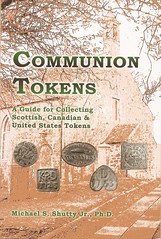
PREV ARTICLE
NEXT ARTICLE
FULL ISSUE
PREV FULL ISSUE
BOOK REVIEW: COMMUNION TOKENS
I've always liked communion tokens, and was glad to see Mike Shutty's book come along. It's a great introduction to this series. For some background on the tokens, here's a short excerpt: The use of church tokens to denote worthiness is not unexpected. The press to separate the devout from the profane has always been of paramount concern. In fact, the word token is derived from the Saxon “tacen” or Gothic “taikns” and refers to a sign or mark of distinction. Consequently, the strict bestowal of tokens represented a convenient and reliable way to recognize the faithful. Church tokens used in this way provided some measure of insurance against infiltration by devious outsiders intent on deception, or worse, religious persecution. It is at this point that the communion tokens, which are the subject of this book, come into play. In fact, they were uniquely suited to the purposes of the early reformation church. John Calvin, one of the chief architects of this movement, is credited with suggesting that tokens be used to determine who in the congregation was worthy of the sacrament of communion. (p10-11) The communion ceremony is described. Here's a passage relating specifically to the collection of the tokens: It was a solemn affair, standing in line, gaining entrance one by one, as the elders inspected each token, and dropped it into the bag with a dull click. A second elder consulted the communion rolls to assure that no one could sneak by with a counterfeit. Yet, some folks did try to sneak by. Church records have revealed instances where an outdated token or a worn halfpenny was passed to gain entrance. These folks were strongly reproved when discovered. In addition, some parishioners with valid tokens were refused at the last moment when recognized by another member of the congregation as being a drunkard, a fornicator, or a witch. (p19) Like many authors, Shutty ended up writing the book he'd always wanted to read. While there are many other books on the topic, most are fairly specialized catalogs with long lists of tokens but little information for a beginner. His book fills that gap admirably. The first chapter ("Bits of Lead and Tin") discusses his first encounter with a communion token and subsequent search for more information about them. The chapter includes a brief overview of the primary literature on the subject. The next two chapters ("A Tradition Develops" and "Fencing the Table") describe the historical background and the actual ceremony of Communion. Chapter Four ("Molding and Striking") describes the primary methods of manufacture. Chapters Five and Six cover the churches and the towns they were part of. All eighteen chapters of the book are short and easy to read, with none being more than about 10 pages long. Chapter Seven is a closer look at the fields of collecting communion tokens, which includes another look at the primary literature and different organizing schemes (such as collecting communion tokens by date, place, style or shape). Each chapter from Eight through Fifteen covers one of these organizing schemes, including shape ("Squares", "Rounds", "Rectangles", "Ovals", "Odd Shapes"), place ("Canada", "United States"), and "Table Numbers". I wasn't aware of the last type of communion token, used for large ceremonies where table numbers are hand punched into the tokens. Rounding out the book are chapters on "The Token Marketplace" and "Caring for Tokens". This 137-page book is an excellent introduction to communion tokens of the world. While being a book meant for beginning collectors of the series, it covers the material thoroughly. With a three-page list of References, it passes my back-of-the-book test for numismatic scholarship. In summary, Communion Tokens is good reading for anyone who's ever sat in a pew, and I would include synagogues, too: the early history of the Christian Church is one of persecution, and communion tokens were born of that stress. These little tokens are badges of both membership and worthiness, with something in common even with the challenge coins of today. I'm going to pass this along to my father-in-law; it's a book appropriate for lay readers as well as seasoned numismatists. I recommend it to E-Sylum readers. Communion Tokens: A Guide to Collecting Scottish, Canadian & United States Tokens is available on the Wasteland Press website: Books123.org. For more information about the book or the tokens, check out the blog at communiontokens.blogspot.com .
To read the earlier E-Sylum article, see:
NEW BOOK: COMMUNION TOKENS
(www.coinbooks.org/esylum_v16n29a03.html)
The Numismatic Bibliomania Society is a non-profit organization promoting numismatic literature. See our web site at coinbooks.org. To submit items for publication in The E-Sylum, write to the Editor at this address: whomren@gmail.com To subscribe go to: https://my.binhost.com/lists/listinfo/esylum All Rights Reserved. NBS Home Page Contact the NBS webmaster 
|
